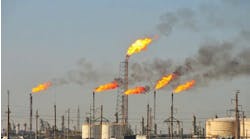I HAVE an application in which we’re mixing chlorine and nitrogen, and measuring the flow rates as they enter the mixing vessel. What I’m trying to do is calculate the ratio of chlorine to the total mixture. Later in the process, I’m measuring the flow of the mixture into a process, and using the ratio to calculate the amount (weight) of chlorine consumed by the process.
Presently, I’m taking a reading from the chlorine and nitrogen flowmeters every second, summing the two readings, and then dividing the chlorine flow by the sum to get the ratio of chlorine in the mixture at that point in time. This value is then averaged over a time period.
Is this a valid way to determine the ratio of chlorine to total gas mixture? It seems to me that since these are two different gases, with different densities, and possibly at different delivery pressures, this is not a valid way to calculate the ratio. Thanks for any input.
David Hendel, Loman Control Systems Inc.
ANSWERS:
Integrate Readings for Gas Concentration
If you’re working with mass flowmeters (Coriolis, thermal, etc.), then all you need to do is integrate their readings for a time equaling the displacement of the mixer, and the ratio Cl/(N+Cl) will give you the weight % concentration of chlorine.
If your flow sensors are volumetric (orifice, etc.), you determine mass flow using W = 218d2(hD/[1-b4), in which W is in lb/hr, h is in. of water, D is density in lb/ft3, and beta is the orifice ratio of a flange-tap orifice. In this equation density is D = MwP/10.73TZ, in which Mw is the molecular weight, P is pressure in PSIA, T is the gas temperature in Rankine, and Z is the compressibility of the gas.
For more details, refer to Volume 1 of my Instrument Engineer’s Handbook.
Béla Lipták, PE, CONTROL columnist
Compressibility Complicates Calculations
I would note that the chlorine flowmeter may well be operating in a region where the compressibility is varying rapidly with P&T—boiling point 10 ºC at 500 kPa(abs). If this is so, then calculating the mixture density gets a little more complicated.
Ian H. Gibson
Use Coriolis for Two-Component Concentration
For the mixture stream, computation of a mass flow from temperature and pressure presumes the molecular weight of the mixture is known, which implies the concentration of the mixture is known. Therefore, I would favor a true mass flowmeter, such as the Coriolis meter, because its density measurement would also give you the concentration of a two-component mixture.
Greg McMillan, CONTROL columnist
Photometric Analyzers, Feedback Control Yield Accuracy
If precise control of chlorine concentration is required, I’ve used photometric analyzers to monitor the chlorine concentration in the mixed gas in similar applications. With feedback control, I’ve been able to provide highly accurate results.
Bob Saltzman
Ratio Control Nitrogen to Chlorine
After getting both flows to mass flow, this could be an excellent opportunity for ratio control of the nitrogen to the chlorine going into the mixer. The amount of chlorine consumed by the process is the average mass flow of the chlorine.
Kevin Totherow, Sylution Consulting




